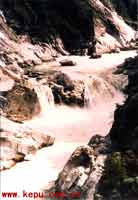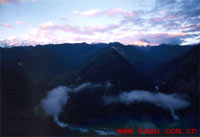Cause of Formation
 |
|
Distant view of Zangbo Badong Waterfall
(Li Bosheng) |
The ^mountain and the river ̄ of the great canyon mainly refer to
^Mount Namjagbarwa ̄ surrounded by the great canyon and the great canyon itself. The formation of the river and the mountain has interrelations. Here, I must highlight the geological basis for the formation of rivers and mountains. The expedition research indicates, geologically, the great canyon locates in the intersecting and overlapping part of the Himalayas, Gangdisi-Nyainqentanglha Mountain and the Hengduan Mountain. The mountain systems mix together. The mountain is particularly high and the river is particularly deep. In the aspect of geological tectonic formation, the great canyon locates in a place where the Indian plate drifts towards the east and it squeezes the relatively passive Europe-Asian plate; it dives downwards and collides the Europe-Asian plate with a low angel; while its east side is counteracted by the giant Pacific plate. Since it locates in such a place, under such compound action and intense press, strong upraising and
 |
|
Watching twilight in the morning beside
Palong Zangbo River |
transformation appear. The crust and mantel substance interact with each other. The mantle substance upraises and whirls, and produces the "thermal eddy" action. All these interact with the outer layer of the crust and forms the complicate "earth tie" in the east of Himalayas. The violent upraising in tectonic and the transformation constitute rather complicate tectonic bows. The rocks in the crust are affected at least twice by the metamorphic action, which produces a set of middle or deep metamorphic rock system. Such geological and tectonic conditions, plus the action of the external agent with the running current taking the lead, are the main causes of formation for the river and the mountain in the great canyon district. On the basis of the above-mentioned geological environment, the mountain and the river of the great canyon region appear concurrently in a special intersecting part of the three mountain systems and a special part of the interacting action of the three plates and form the high mountains and deep valleys with the greatest rise and fall in topography on earth. The features with them are that the mountains are especially high; and the valleys are extremely deep. In the meantime, the scientists also illustrated that the great bend canyon in the downstream of the Yarlung Zangbo River-the largest canyon of the world - is a tectonic antecedent river and they vetoed some scholars' assumption that the Yarlung Zangbo river was a captor river and the great canyon was an elbow of capture.
|